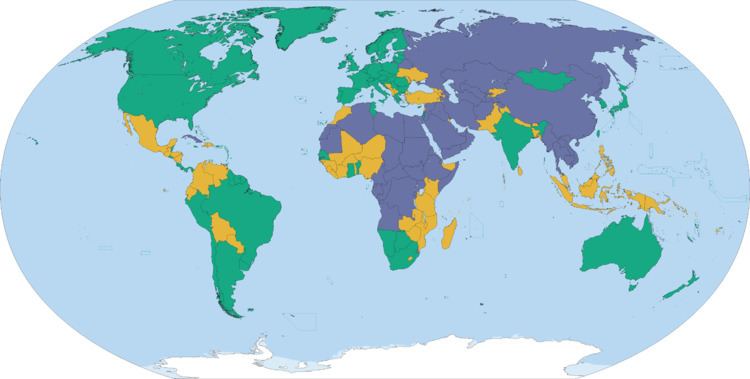This article contains a list of freedom indices produced by several non-governmental organizations that publish and maintain assessments of the state of freedom in the world, according to their own various definitions of the term, and rank countries as being free, partly free, or unfree using various measures of freedom, including civil liberties, political rights and economic rights.
The Human Freedom Index presents the state of human freedom in the world based on a broad measure that encompasses personal, civil, and economic freedom. The index presents a broad measure of human freedom, understood as the absence of coercive constraint. It uses 76 distinct indicators of personal and economic freedom. The index covers the following areas: Rule of Law, Security and Safety, Movement, Religion, Association, Assembly, and Civil Society, Expression, Relationships, Size of Government, Legal System and Property Rights, Access to Sound Money, Freedom to Trade Internationally, and Regulation of Credit, Labor, and Business. The Human Freedom Index was created in 2015, covering 152 countries for years 2008, 2010, 2011 and 2012. In January 2016 data for 2013 was added, covering 157 countries. The report is co-published by the Cato Institute, the Fraser Institute, and the Liberales Institut at the Friedrich Naumann Foundation for Freedom.
The CIRI Human Rights Data Project measures a range of human, civil, women's, and workers' rights. It was created in 1994 and is now hosted by the University of Connecticut. In its 2011 report, the U.S. was ranked 38th in overall human rights.
The Democracy Index, published by the U.K.-based Economist Intelligence Unit, is an assessment of countries' democracy. Countries are rated to be either Full Democracies, Flawed Democracies, Hybrid Regimes, or Authoritarian regimes. Full democracies, flawed democracies, and hybrid regimes are considered to be democracies, and the authoritarian nations are considered to be dictatorial. The index is based on 60 indicators grouped in five different categories measuring pluralism, civil liberties, and political culture.
The Economic Freedom of the World Index is a report published by Canada-based Fraser Institute in conjunction with the Economic Freedom Network, a group of independent research and educational institutes in 90 nations and territories worldwide. It is a numeric index, and its results are not currently included in the table below.
Freedom in the World, published each year since 1972 by the U.S.-based Freedom House, ranks countries by political rights and civil liberties that are derived in large measure from the Universal Declaration of Human Rights. Countries are assessed as free, partly free, or unfree.
Freedom of the Press is a report published each year since 1980 by Freedom House.
The Index of Economic Freedom is an annual report published by The Wall Street Journal and the U.S.-based Heritage Foundation. Countries are assessed as free, mostly free, moderately free, mostly unfree, and repressed.
The Index of Freedom in the World is an index measuring classical civil liberties published by Canada's Fraser Institute, Germany's Liberales Institute, and the U.S. Cato Institute. It is not currently included in the table below.
MaxRange, developed by Max Rånge, and maintained by Mikael Sandberg and Max Rånge, political scientists at Halmstad University, Sweden, is a data set defining a country's level of democracy and institutional structure (regime-type) on a 1000-point graded scale. Values are sorted based on level of democracy and political accountability. MaxRange defines the value corresponding to all states every month from 1789 to the present.
The U.S.-based Polity data series is a widely used data series in political science research. It contains coded annual information on regime authority characteristics and transitions for all independent states with total populations greater than 500,000 and covers the years 1800–2006. Polity's conclusions about a state's level of democracy are based on an evaluation of that state's elections for competitiveness, openness, and level of participation. Data from this series is not currently included in the table below. The Polity work is sponsored by the Political Instability Task Force (PITF) which is funded by the U.S. Central Intelligence Agency; however, the views expressed in the reports are the authors' alone and do not represent the views of the U.S. Government.
Worldwide Press Freedom Index, is published each year since 2002 (except that 2011 was combined with 2012) by France-based Reporters Without Borders. Countries are assessed as having a good situation, a satisfactory situation, noticeable problems, a difficult situation, or a very serious situation.
The World Index of Moral Freedom was first published on April 2, 2016 by the Foundation for the Advancement of Liberty, based in Madrid, Spain. This index ranks 160 countries by five categories of indicators: religious freedom, bioethical freedom, drugs freedom, sexuality freedom and family and gender freedom. The index aims at establishing the degree of individual freedom or state control on decisions pertaining to the great moral debates of our time.
Here is a table of the assessments by three indices, for most countries of the world. For exact rankings rather than assessments, refer to the individual index articles.
Source: Reporters Without Borders

